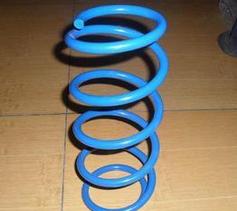 Plastic springs can simplify the design structure and save costs, but they cannot simply apply the design method of metal springs. In general, plastics can only be used for springs that do not require instantaneous recovery. The plastic spring is preferably operated intermittently, that is, the spring generates a short-time prescribed force, while the other time is in a relaxed state. The spring recovery time of the plastic spring should be at least equal to the time under load.
Plastic springs can simplify the design structure and save costs, but they cannot simply apply the design method of metal springs. In general, plastics can only be used for springs that do not require instantaneous recovery. The plastic spring is preferably operated intermittently, that is, the spring generates a short-time prescribed force, while the other time is in a relaxed state. The spring recovery time of the plastic spring should be at least equal to the time under load. The use of plastic springs is not limited because most springs are not used continuously. In the design of plastic products, this issue must be considered. Nevertheless, the application of plastic springs in certain product designs has been very successful. For example, the spring in the twistlock is only used to adjust the rotational stress. The lock shown in Fig. 1 is locked and released only by the spring. It is very reasonable to use a plastic spring in this case.
Advantages of plastic springs: The properties of metals are unmatched by plastics. For example, the flexural modulus of steel is 30 to 100 times that of commonly used injection molded plastic springs. However, the plastic spring has its specific application space. Compared with the metal spring, its advantages are as follows: Parts are integrated: At this point, the metal spring can compete with the metal spring and the plastic spring has an integrated difference. That is, designers can use plastic springs creatively. The integration of parts means a simplified structure, easy installation, lower cost, and lighter weight. Recyclability: Parts with metal springs are often scrapped if they fail to meet quality and specifications. Plastic springs allow all parts to be recycled. Corrosion resistance, "does not rust." Natural smoothness, with the convenience of molding and coloring. Manufacturing costs are reduced relative to machining.
Springs and their creep: For springs made of plastics, pay attention to the difference in bending modulus between metal and plastic. Alternative resins include polyethylene, polypropylene, polyester, ABS, nylon, and polyethylene. The resilience of the material is an important selection factor. Compared to metals, springs made of the best resins will soon age and fail under sustained loads. The acetyl polymer loses 50% of the original elastic force after 1000 hours (approximately 6 weeks), loses 60% of the original elastic force after 10,000 hours (about 1 year), and after 100,000 hours (approximately 11 years) ) Loss of two-thirds of the original elasticity. In general, crystalline acetyl and polyphenylene have better creep resistance than polyethylene and ABS. If the mold temperature is too low, the creep rate of the crystalline material will increase significantly during the final stages of the injection molding process.
The choice of material: The choice of material for the spring depends on the desired properties. The factors to consider are creep resistance, load, fatigue limit, and chemical resistance. Acetyl polymers are the most commonly used materials. Other available materials and their properties are as follows: Polyethylene and polypropylene are inexpensive, but poor stretch recovery and poor creep resistance. They can only be used for short-term loads, have a moderate fatigue response, but are chemically resistant. Acrylic copolymers are relatively expensive, but have good continuous load characteristics and good creep resistance, but they are not suitable for working in acidic environments of less than 4 pH. The linearized polyphenylene materials are more brittle than acetyl copolymers and are more suitable for high load, small displacement applications. It has good creep resistance, good fatigue resistance, and can maintain its toughness at high temperatures. It can also work normally for a long time when it is exposed to chemical attack. Nylon is more resistant to wear under dry conditions, but when exposed to 50% relative humidity, its stiffness is reduced by up to 25%.
For simple, occasionally used springs, the use of ABS is appropriate, but its creep resistance is poor. Using fillers in the material improves the spring's characteristics. Filling the glass fiber in the material increases the rigidity and strength, but its deflection is limited. Ambient temperature also affects the performance of plastic springs. Most plastics have the best characteristics at room temperature. The higher the ambient temperature, the closer the material of the spring is to the softening point. In addition, consider the issue of UV protection. If the plastic spring is installed inside the product or installed in the backlight, the problem of plastic aging caused by ultraviolet radiation can be avoided. For those products that are used outdoors, such as garden tools and sports equipment, the irradiation of ultraviolet rays can destroy the spring effect. Under such conditions, it must be determined based on the UV-resistant typical data of the material that the selected material can work under UV exposure.
Bonded Magnet,Bonded Rare Earth Ndfeb Magnet,Bonded Ndfeb Permanent Magnets,Ndfeb Bonded Magnet
Honesun Industrial Co.,Limited , http://www.chinamagnetise.com